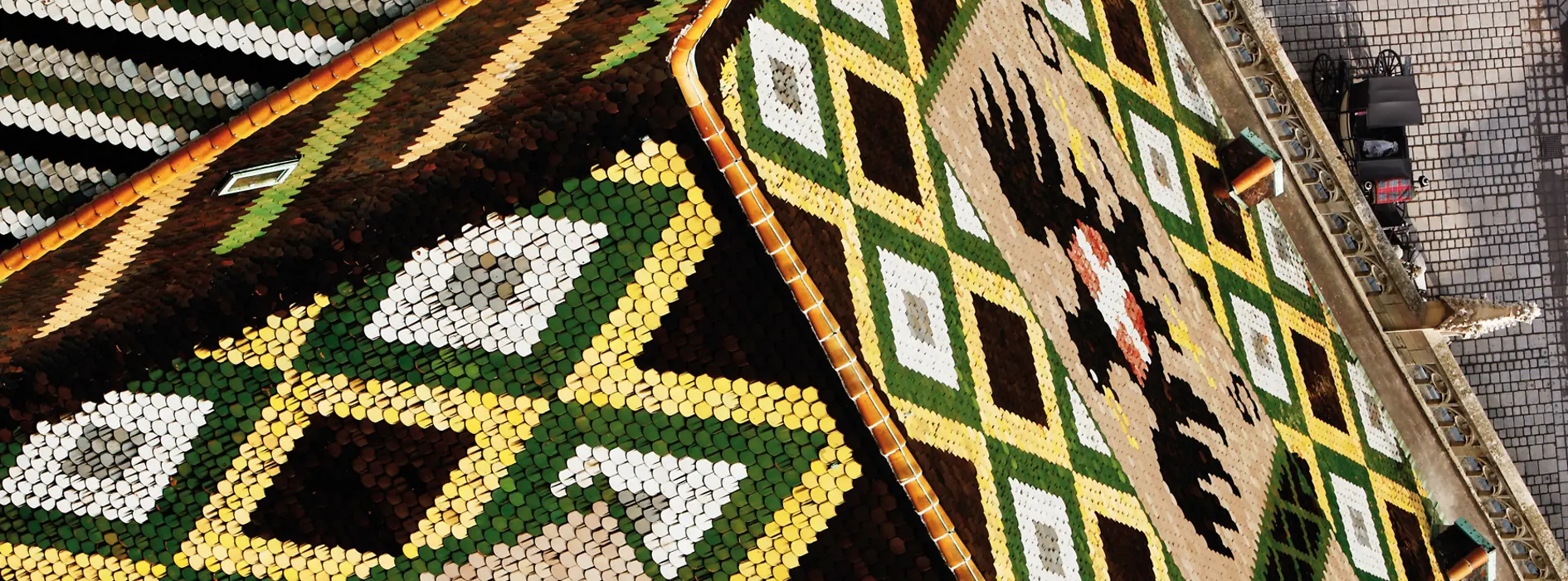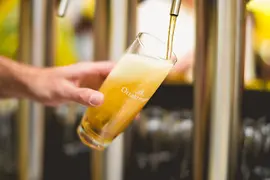Vienna Press Release – June 2024 Vienna in a glass
Viennese wine
The Celts and Romans are said to have grown vines in the area which is now occupied by Vienna. Today, Vienna is the only metropolis in the world with a significant wine-growing industry within its city limits. An average of some 2.5 million liters can be produced each year across 600 hectares of vineyards. White wine is grown on around 85% of that land. Particularly popular varieties include Grüner Veltliner, Riesling, Pinot Blanc, Chardonnay and a real specialty: Wiener Gemischter Satz. Only a wine that consists of at least three grape varieties that are grown, harvested and pressed together in one vineyard can be labeled a Wiener Gemischter Satz. Once neglected, this specialty has now been awarded the DAC quality label and the prestigious Presidio seal from Slow Food. Most recently, in April 2024, the EU Commission added Wiener Gemischter Satz to the list of wines with protected designations of origin. This means that the method is now officially unique.
Around half of the wine comes from the hilly north-west of the city, as well as traditional growing areas north of the Danube and in the south of Vienna. The smallest vineyard can actually be found in the heart of the city: on Schwarzenbergplatz. And where does Viennese wine tend to taste best? On site, of course, in one of around a hundred wine taverns that serve wine from their own vineyards. You can also enjoy hot and cold dishes in a relaxed atmosphere. After the meal there is a “Stamperl”, meaning a shot of schnapps, if desired. These are usually various fruit brandies. If you prefer something refreshing, in Vienna – and not just at a Heuriger wine tavern – you should go for a white spritzer. Half white wine, half soda. A spritzer is as much a part of the city’s identity as St. Stephen’s Cathedral and the Giant Ferris Wheel.
Grape juice & sturm
Grape juice is the increasingly popular non-alcoholic representative of the grape family and is made from freshly harvested and pressed grapes. There is a clear trend towards a preference for premium-quality grape juice. Vienna is in fact the first federal state to produce award-winning grape juice. Only grapes from Viennese vineyards end up in “Excellent Viennese Grape Juice”, which is chosen by expert juries.
As summer draws to a close, the sturm season begins in Vienna. Sturm is grape juice that has started to ferment – in other words, it is in the process of becoming wine. Known in Germany as Neuer Wein or Federweißer or Federweisser, Sturm must have at least one percent alcohol and is drunk as white, red or rosé. On an autumnal stroll through the Viennese vineyards, you will discover that almost every establishment serves sturm. However, you can also find it on every corner in the city center. A little bit of sturm etiquette: you should drink it with your left hand and say “Mahlzeit!” without clinking glasses.
Sparkling wine
Whenever there is something to celebrate, the Viennese love to raise a glass of sparkling wine. Again, they have access to a range of products that have deep roots in the city. Sekt, or sparkling wine, which is one of the stages in the refinement of wine, is produced in Vienna by numerous winegrowers and some true pioneers of the Sekt scene. Haus Schlumberger, which today also includes the Viennese brand Hochriegl, was founded in 1842, making it the oldest Sekt producer in Austria. The former purveyor to the imperial and royal court, Kattus, also has a long tradition. Emperor Franz Joseph is said to have treated himself to a bottle of Kattus every Sunday. Both companies also open their cellars in the 19th district to visitors. The popularity of sparkling wine shows no sign of waning: nine in ten Austrians consume the fizzy drink from time to time, according to the “Sektreport”. More and more people are also enjoying the various non-alcoholic versions.
Beer
Vienna has an even longer association with beer: from the Middle Ages until the 19th century, the city was a stronghold of brewers. Today there is only one large brewery left: Ottakringer. Their brewery in the 16th district is also a popular venue for events and parties. In Viennese slang, “16er-Blech” has long since established itself as an expression for a can of Ottakringer (16 stands for the district, Blech for the material the can is made of). Delicious beer brewed in-house is also available in the 15 or so gasthaus breweries spread across Vienna. The emerging Viennese brewing scene is constantly coming up with new creations with its craft beers. Another very popular drink in Vienna is the Radler - beer mixed with lemonade or water. By the way, there are three sizes of beer in Vienna: a Pfiff (125 ml), a Seidl (300 ml) and a Krügerl (500 ml).
Gin
A few years ago, gin embarked on a full-blown triumphal march through the world’s bars and living rooms. Interest in the colorless spirit, which is made from juniper berries and lots of fragrant botanicals, continues unabated in Vienna. Gin is not only drunk here, but also produced. More and more distilleries are springing up. Many bottles of Viennese gin are adorned with the name Klimt and Co. The Vienna Craft Distillery and Munakra Gin have also made a name for themselves. Vienna Distiller offers tastings at a very famous location: the Spanish Riding School. Vienna is also home to the most successful individual female distiller, Alexandra Ghuneim, who runs the gin label HabibiDryGin and won awards in 2023 and 2024. Did you know: experts say that gin does not always need to be accompanied, but it should not be drunk with ice! However, the most popular choice is still the G&T: gin and tonic.
Vermouth
Vermouth has enjoyed a similar rise in popularity in recent years, although it has been around for ages. After all, herbs were already being added to wine in Ancient Egypt and Ancient Greece. As with wine, there are white, red and rosé varieties. Vermouth is regarded as straightforward (a good aperitif!) and not too strong (alcohol content below 22 %). The Viennese Vermouth with the longest tradition has been produced by Burschik since 1891. The company offers tastings and guided tours right next to the Westbahnhof station. Vermouth has become particularly famous thanks to cocktails such as the Martini and Negroni. A Viennese twist can be added to the recipe for the latter: mix Burschik’s Red Vermouth, Vienna Gin and Viennese Dirndl (a liqueur made from cornelian cherries), which is also produced here, in equal proportions. The result is known as a “Negroni, Oida!”
More spirits and liqueurs
Vienna has much more to offer, including products that one would not immediately associate with the city. Kalê is an aromatic herbal liqueur that is drunk neat or mixed – for example as Kalê Spritz or Kalê Sour. It wouldn’t be Vienna if coffee didn’t also find its way into a shot glass: Wiener Mocca from the Naber coffee manufactory is a strong coffee liqueur. In partnership with Manner, Alt Wiener Schnapsmuseum GmbH produces cream liqueurs that taste like liquid chocolate bananas or Neapolitan slices. And for those who like a strong tipple: the traditional company from Vienna-Meidling also produces various absinthes.
Addresses:
- Schlumberger Kellerwelten, Heiligenstädter Straße 39, 1190 Wien, www.schlumberger.at
- Kattus Sektkellerei, Billrothstraße 51, 1190 Wien, kattus.at
- Ottakringer Brauerei, Ottakringer Platz 1, 1160 Wien, www.ottakringerbrauerei.at
- Wien Gin, www.wiengin.at
- Vienna Craft Distillery, viennacraftdistillery.at
- Munakra Gin, www.munakra.com
- Vienna Distiller, Spanische Hofreitschule, Michaelerplatz 1, 1010 Wien, www.viennadistiller.com
- HabibiDryGin, www.facebook.com/habibidrygin
- Burschik Vermouth, Zinckgasse 8, 1150 Wien, www.burschik.com
- Kalê, kale.at
- Kaffeemanufaktur Naber, naberkaffee.com
- Alt Wiener Schnapsmuseum GmbH, fischerspirits.com
Contact
Helena Steinhart
Media Relations
+43 1 211 14-364
helena.steinhart@vienna.info








